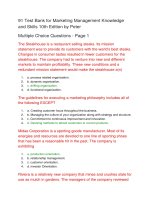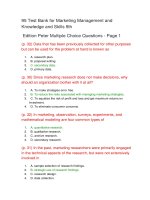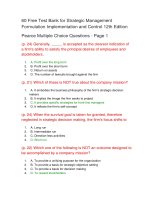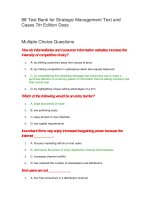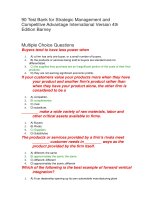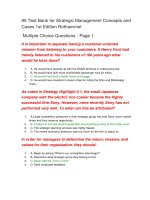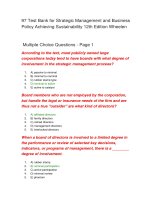95 test bank for strategic management concepts and cases 1st edition rothaermel
Bạn đang xem bản rút gọn của tài liệu. Xem và tải ngay bản đầy đủ của tài liệu tại đây (125.15 KB, 20 trang )
95 Test Bank for Strategic Management Concepts and
Cases 1st Edition Rothaermel
Multiple Choice Questions - Page 1
It is important to separate having a customer-oriented
mission from listening to your customers. If Henry
Ford had merely listened to his customers of 100 years
ago what would he have done?
1.
2.
3.
4.
A. He would have teamed up with the Wright brothers in making bicycles.
B. He would have built more comfortable passenger cars for trains.
C. He would have built a better horse and buggy.
D. He would have invested in steam ships for riding the Ohio and Mississippi
rivers.
As noted in Strategy Highlight 2.1, the small Japanese
company with the electric rice cooker became the
highly successful firm Sony. However, more recently
Sony has not performed very well. To what can this be
attributed?
1.
A.Large competitive pressures in their strategic group has cost Sony much market
share and thus revenue opportunity.
2. B. A failure to set new stretch goals after accomplishing many of their older ones.
3. C. The strategic planning process was highly flawed.
4. D. The recent economic downturn was too much for the firm to adjust to.
In order for managers to determine the vision, mission, and
values for their organization, they should:
1.
2.
3.
4.
A. Begin by asking "What is our competitive advantage?"
B. Determine what strategic group they belong to first.
C. Begin with the "end in mind."
D. Seek employee feedback.
Visionary companies differ from their competition in that:
1.
A. Employees in visionary organizations find meaning in their work and are
motivated.
2. B. A visionary company focuses on scenario planning and future competitive
threats.
3. C. In a visionary company it is the CEO's managerial style that gives the company
its emergent strategy.
4. D. Visionary companies typically emphasize measuring financial performance.
When an organization briefly describes what its business is
about and why it does it, they have articulated a
_______________.
1.
2.
3.
4.
A. Values statement
B. Mission statement
C. Strategic plan
D. Competitive advantage
The ethical standards and norms that should govern the
behavior of the individuals within the firm are called
what?
1.
2.
3.
4.
A. Values
B. The mission
C. The strategic plan
D. Competitive advantage
The 2001 collapse of Enron, resulting in one of the biggest
bankruptcies in U.S. history, demonstrates that:
1.
A. An organization may have a mission statement promoting ethical behavior, but
it must have strong organizational values to guide the behavior of employees.
2. B. Employees observe managerial behavior and tend to follow it.
3. C. Having strong ethical values inside an organization is important for long-term
success.
4. D. All of these.
Staking out a desired leadership position that far exceeds a
company's current resources and capabilities is called
what?
1.
2.
3.
4.
A. Strategic planning
B. Strategic management
C. Strategic intent
D. Strategic process
Organizational values help people make choices that are
ethical and company-goal-oriented. These values
answer which strategic management question?
1.
2.
3.
4.
A. What do we want to accomplish as a firm?
B. How do we accomplish our goals in the organization?
C. What are we about as a firm relative to our competitors?
D. What is the best way to compete in the marketplace?
As noted in Strategy Highlight 2.1, the small Japanese
company with the electric rice cooker faced very long
odds in getting a license from Bell Labs for using their
transistor. The end result of the effort to get the license
was what?
1.
A. The Japanese firm got the license but was not able to produce the desired
radio.
2. B. The Japanese firm got the license and used it successfully in their rice cooker.
3. C.The Japanese firm introduced the first pocket-sized radio, but the market was
not ready for it and sales were weak.
4. D. The Japanese firm introduced the world's first pocket-sized radio to great
market success.
McKesson, a $110 billion health care company, is provided
as an example firm with clear and compelling
organizational values. All of the following items are
examples of living the values EXCEPT which one?
1.
2.
A. The ethics and behavior models are the cornerstones of building the business.
B. ICARE values are printed out on all their marketing materials for new
customers.
3. C. Employees worked long overtime hours to meet urgent needs during hurricane
Katrina.
4. D. The ICARE values serve as a framework for how to deal with their customers.
A set of values illustrates the firm's __________.
1.
2.
3.
4.
A. choice of where to do business
B. definition of what business is and why it does it
C. ethical standards and norms
D. positioning of what the business did in the past
The process that describes the method by which managers
conceive of and implement a strategy that can lead to
a sustainable competitive advantage is called what?
1.
2.
3.
4.
A. Strategic process
B. Strategic technology
C. Strategic management
D. Strategic planning
Better World Books (BWB) wanted to fight illiteracy by
donating 50 percent of its revenues, as stated in its
mission. The fact that it had to later reduce the
donation amount to between 7-10 percent is a
reflection of the fact that:
1.
A. The declared mission of an organization can sometimes negatively impact its
financial performance.
2. B. The declared mission of an organization is often too complicated to execute.
3. C. The declared mission of an organization needs to be product-oriented.
4. D. The declared mission of an organization should not include financial
measurements.
Mission statements can also be used to help refocus a firm
on its main line of business. One example of this given
in the text is:
1.
2.
3.
4.
A. Ben & Jerry's expanding beyond ice cream into other food categories.
B. Disney selling off its theme parks to focus on movies.
C. Shell Canada selling off its chemicals and forestry businesses.
D. Ford Motors moving into hybrid cars and SUVs.
To be effective, firms must implement their mission
statements in strategic actions. The decision that
Boeing made to develop the 787 Dreamliner is an
example of what?
1.
2.
3.
4.
A. A costly and long-term strategic commitment
B. An attempt to win U.S. military contracts
C. The results of an emergent strategy
D. A customer-oriented mission statement
Teach For America (TFA) has an inspiring mission, which is
to eliminate educational inequality in the U.S. What is a
major benefit discussed that TFA garnered by
effectively using this mission?
1.
2.
3.
4.
A. An extensive network to use for job openings at the end of two years of service.
B. Significant supplemental income for the TFA workers while in the field.
C. Scholarships for graduate programs at the end of the two years.
D. A large number of applicants driving a highly selective group in the teaching
jobs.
Mission statements have been shown to be associated with
firm performance. In many cases, organizations with
sound missions are more successful; however, what is
far less clear is ________.
1.
A. that customer-oriented missions provide more flexibility than product-oriented
ones
2. B. whether this mission actually causes a firm to have a competitive advantage
3. C. whether missions can be inspirational for both employees and customers
4. D. whether the mission should describe what the firm actually does
It has been found that visionary companies outperform other
companies by more than 1,400 percent. One reason for
this is:
1.
2.
3.
4.
A. Their stated missions encapsulate their aspirations.
B. Their employees are better trained.
C. They are focused on profits.
D. They are typically start-ups and are thus more highly motivated.
Chinese companies such as BYD and Lenovo made global
leadership their mission. One of the tools they used to
accomplish this position is what?
1.
2.
3.
4.
A. Stretch goals
B. Efficient goals
C. Reach goals
D. Enhanced goals
Many of the early U.S. railroad companies defined
themselves as being in the railroad business instead
of being in the transportation needs business. These
companies used ______________.
1.
2.
3.
4.
A. resource-based missions
B. customer-oriented missions
C. product-oriented missions
D. responsive missions
A business statement defined in terms of a good or service
provided is called a _______________.
1.
2.
3.
4.
A. customized mission
B. service-centered mission
C. product-oriented mission
D. customer-centered mission
Google's decision in 2010 to pull its servers out of mainland
China and operate out of Hong Kong was a response
to what?
1.
2.
3.
4.
A. A drive to increase profits with a broader footprint in Asia.
B. A request from the Chinese government to leave the country.
C. A move to cut costs due to intense competition with the local search firm Baidu.
D.Google's decision to stop using self-censoring, as required by the Chinese
government to stay operating in mainland China.
Teach For America (TFA) recruits recent college graduates
and professionals to teach for a two-year commitment
in socially and economically disadvantaged
communities. What is a major component of their
recruiting campaign for applicants?
1.
2.
3.
4.
A. An extensive network to use for job openings at the end of two years of service.
B. An inspiring mission to eliminate educational inequality.
C. Significant supplemental income for the TFA workers while in the field.
D. Scholarships for graduate programs at the end of the two years.
When Disney says its mission is "to make people happy,"
they translate that mission into which of the following
actions as discussed in the text?
1.
2.
3.
4.
A. Employees are screened for their acting ability at all levels of the organization.
B. They bought Pixar to make more movies that audiences would enjoy.
C. They adjust their ticket prices seasonally to meet customer demand.
D. Employees are cast members to help the customers enjoy the "show"
throughout the park.
A mission describes ____________.
1.
2.
3.
4.
A. what a business will do in the future
B. what a business actually does and why it does it
C. what the norms are of the business
D. what the business has done historically
Intel is provided as an example of a firm that has
continuously changed its mission statement, including
most recently moving to a customer-focused mission.
This is an indication of what?
1.
2.
3.
4.
A. Missions are best left as they were originally crafted for the firm.
B. Intel's mission likely created its superior performance over this period.
C. Missions can be inspirational for both employees and customers.
D. The mission was changed after Intel had already changed its business focus.
The analogy about building a new home is relevant to
strategy because you use vision, mission, and values
to begin with the end in mind. Strategic success must
be created twice. Once by creating a clear mental
picture of what the firm wants to accomplish and
second ____________.
1.
2.
3.
A. by formulating and implementing a strategy to make the vision a reality
B. by holding department meetings to communicate the vision
C. to create a strong value system that will bind the company together in tough
times
4. D. by creating a blueprint for the organization to use in creating new mission
statements
Customer-oriented missions are defined as
__________________.
1.
2.
3.
4.
A. providing solutions to employee needs
B. providing solutions to customer needs
C. providing solutions to executive needs
D. providing solutions to stockholder needs
Which of the following is NOT true concerning a customeroriented mission?
1.
2.
3.
4.
A. It defines the means of how a customer need will be met.
B. It has more flexibility than a product-oriented mission.
C. It has a higher likelihood of remaining relevant in the long-term.
D. Organizations that have customer-oriented missions are more likely to be
successful.
When it comes to a firm's vision, mission, and values, it can
be said that:
1.
A. Once instituted in the organization, the vision, mission, and values of a firm
should be left alone, regardless of whether the company is successful or not.
2. B. New firms have to create these by using a driving vision to shape their mission
and values, and existing firms should fine-tune their mission and values and
reaffirm their values periodically.
3. C. New firms should modify their vision, mission, or values as they grow, but
established firms should stick to what has worked in the past.
4. D. Existing firms should regularly discard their vision and mission in a renewal
process.
Which one of the following best describes a product-oriented
mission?
1.
2.
A. It defines the means of how a customer need will be met.
B. It is the best type of mission for most firms to have.
3.
4.
C. It has a higher likelihood of remaining relevant in the long-term.
D. It defines a business in terms of a good or service provided.
Strategic intent is considered to be forward-looking and
future-oriented. It is most useful in situations where
_______________.
1.
2.
3.
4.
A. large firms are close competitors with others
B. all the firms competing in a market are very similar
C. small firms are wanting to compete against bigger, more established firms
D. the dominant plan from a scenario planning process is identified
If the early U.S. railroad companies defined themselves as
being in the transportation needs business, which is
more customer-oriented, they might have successfully
moved into what product/service before any other
firm?
1.
2.
3.
4.
A. Commercial aviation (such as Delta and United)
B. Modern shipping and logistics (such as FedEx and UPS)
C. International cargo containers on large ocean ships
D. Fuel efficient automobiles (such as Toyota and Ford)
68 Free Test Bank for Strategic Management
Concepts and Cases 1st Edition Rothaermel
Multiple Choice Questions - Page 2
When strategizing for competitive advantage, managers rely
on different approaches that can complement one
other. Which one of the following is NOT an approach
a firm may use?
1.
2.
3.
4.
A. Strategic planning
B. Strategy as planned emergence
C. Strategy implantation
D. Scenario planning
In Strategy Highlight 2.3, what type of strategy is the store
manager of Starbucks using to develop new drinks for
the stores?
1.
2.
3.
4.
A. She is using a rational planning approach to strategy.
B. She is creating a dominant strategy plan.
C. She is using scenario planning.
D. She is using an emergent strategy process.
A dominant strategic plan in the scenario planning tool is
which of the following managerial options?
1.
2.
3.
4.
A. It most accurately matches reality.
B. It matches the intended strategy.
C. It will be the only correct strategic plan.
D. It will be the only correct competitive advantage plan.
In scenario planning, what is the key question to ask to
begin to generate different scenarios?
1.
2.
3.
4.
A. What's happening now?
B. Where are we?
C. What if?
D. Where are we going?
Any unplanned strategic initiative undertaken by mid-level
employees of their own volition is a(n)
________________.
1.
2.
3.
4.
A. dominant strategic plan
B. developing strategy
C. emergent strategy
D. strategic initiative
Based on external and internal analyses, top-level executives
design a rational and structured strategic plan that is
called ____________.
1.
2.
3.
4.
A. scenario planning
B. an emergent strategy
C. an intended strategy
D. an unrealized strategy
The combination of intended and emergent strategies is
called a(n) _______________.
1.
2.
3.
4.
A. unrealized strategy
B. realized strategy
C. dominant strategy
D. developing strategy
Questions such as "What resources do we need if this
happens?" and "How can we shape our anticipated
future environment?" are performed under what stage
of the AFI framework?
1.
2.
A. The formulation stage
B. The forecasting stage
3.
4.
C. The installation stage
D. The iteration stage
A real options perspective is similar to what corporate
finance tool?
1.
2.
3.
4.
A. Present volume
B. Future value
C. Net present value
D. Current yield
Strategic thinking is different than strategic planning in that:
1.
A. Strategic thinking includes "soft" information and employee experience;
strategic planning does not.
2. B. Strategic thinking relies more on hard numbers than strategic planning.
3. C. There really isn't that much that differentiates the two.
4. D. Strategic thinking can create an illusion of control, while strategic planning
avoids this.
Bottom-up strategies can emerge as a consequence of the
firm's RAP. What is the meaning of RAP?
1.
2.
3.
4.
A. Realized Allowance Process
B. Resource Allowance Program
C. Resource Allocation Process
D. Realized Allocation Program
Firms that are willing to pursue exploring and developing
new products and processes, and thus new markets or
new ventures, by definition use a(n)
_________________.
1.
2.
3.
4.
A. emergent strategy
B. developing strategy
C. dominant strategic plan
D. strategic initiative
The strategy originally planned by senior management is
known as:
1.
2.
3.
4.
A. Purposed strategy
B. Impact strategy
C. Intended strategy
D. Emergent strategy
Real options is a business decision and is seen as
_______________.
1.
2.
A. a right and an obligation
B. a right and not an obligation
3.
4.
C. risky and mandatory
D. a requirement for doing business
Planned emergence in strategy-making is when:
1.
2.
A. An organization plans to emerge into a new market using current initiatives.
B. An organization has a succession plan when the current CEO is preparing to
retire.
3. C. An organization communicates its strategy to the lower levels during a planned
event.
4. D. An organization allows bottom-up initiatives to emerge and be considered by
the top.
The strategic management process follows which strategy
framework?
1.
2.
3.
4.
A. AFI; Analyze-Formulate-Implement
B. AFE; Analyze-Formulate-Execute
C. API; Analyze-Plan-Implement
D. APE; Analyze-Plan-Execute
Strategic initiatives describe the activities of firms when they
explore and develop new products and processes, and
new markets or new ventures. Where do strategic
initiatives come from within the organization?
1.
2.
3.
4.
A. They may be the result of top-down OR bottom-up processes.
B. They only emerge using a bottom-up process.
C. They only result from a top-down approach.
D. None of these.
One concept behind linking RAP, decision making, and
strategy is:
1.
A. How an organization uses its resources drives the decisions it makes, which
can alter the strategy.
2. B. Decision making is based on realized strategy, not the resources available.
3. C. Firm resources and decision making do not affect intended strategy except in
times of crisis.
4. D. In line with the tenets of strategic planning on a five-year cycle.
Strategic planning differs from scenario planning in that:
1.
2.
A. Strategic planning is long-term planning; scenario planning is not.
B. Strategic planning is bottom-up from the employees, and scenario planning is
top-down from the CEO.
3. C.Strategic planning is performed by many layers in the organization, while
scenario planning is limited to top executives.
4. D.Strategic planning assumes that future success can be predicted; scenario
planning allows for more unforeseen events.
Managers may use _____ perspective to decision making
where a large investment decision is broken down into
a set of smaller decisions that are staged sequentially
over time to obtain more information.
1.
2.
3.
4.
A. a real options
B. a realized strategy
C. a net present value
D. scenario planning
Strategic flexibility is achieved by:
1.
2.
A. Managers developing a dominant plan and sticking to it.
B. Managers responding when reality changes by activating alternate dominant
plans.
3. C. Ignoring feedback from the marketplace while creating new plans.
4. D. Breaking the cycle of strategic planning-monitoring-responding.
The 2001 collapse of Enron resulted in the loss of jobs for
over 20,000 employees. Arthur Anderson was also
impacted by the Enron collapse and 30,000 employees
lost their jobs. Why was Arthur Anderson so adversely
affected by Enron's collapse?
1.
A.Enron was a major client and Arthur Anderson could not survive the business
downturn from the bankruptcy.
2. B. The firm was an accomplice in the accounting scandal at Enron.
3. C. Arthur Anderson was the target of a hostile takeover directly after Enron's
collapse.
4. D. The accounting firm decided to get out of the entire energy sector as a result of
the collapse of Enron.
Unrealized strategy is when a part of the firm's strategy
________________________.
1.
2.
3.
4.
A. is discontinued due to unexpected events
B. is evaluated because of expected events
C. is eliminated due to expected events
D. is incorporated due to unexpected events
Employees at Google spend one day a week working on their
own ideas. This is an example of a ________________.
1.
2.
3.
4.
A. planned initiative
B. strategic initiative
C. product-oriented strategy
D. consumer-oriented strategy
Applying a real options perspective to strategic decision
making allows for:
1.
A. Breaking investment decisions into smaller, staged phases while obtaining new
information about the project viability as it continues.
2. B.Calculating the net present value of an investment and deciding whether or not
to complete the project from the start.
3. C.Starting a project with a realistic perspective that the organization will not be
able to achieve competitive advantage with.
4. D. Making sure that the project is customer-oriented as opposed to productoriented.
Nucor Corporation is the largest steel company in the U.S.,
has been profitable for decades, and has never laid off
an employee. Yet, Nucor has no written strategic plan,
no written mission statement and no written
objectives. What does this tell us?
1.
A.Nucor should have had written these down but they were fortunate because
they had first-mover advantages.
2. B.Nucor is a monopoly and therefore it is not important to have written plans,
mission statements, or objectives.
3. C. Not having a written strategic plan does not indicate a lack of strategy; it is the
pattern of actions across the organization that is important.
4. D. Not having a written strategic plan could make Nucor vulnerable in the future
because it does not have a strong organizational culture.
The fact that many organizations were caught off-guard by
the recent economic downturn reflects that:
1.
2.
A. It is impossible to prepare for future situations.
B. There is a tendency to ignore negative outcomes when creating future
scenarios.
3. C. "What if" questions are actually not that useful.
4. D. Managers usually wait until it is too late to implement strategic initiatives.
One of Henry Mintzberg's criticisms of the strategic planning
process is that:
1.
2.
3.
4.
A. It does not allow for strategic thinking.
B. It rarely, if ever, gets implemented.
C. It is too reliant on employee feedback.
D. Managers do not like to use it.
Shell Oil is provided as an example of a firm effectively using
scenario planning. In the 1960s, they prepared for a
strong OPEC and therefore rising oil prices. What are
they now predicting about future energy needs?
1.
2.
A. Energy needs will continue to grow, spurred by BRIC countries.
B. In 2025, that 20 percent of our energy will be generated from renewable
technologies.
3. C. That the Middle East leadership will fracture and oil prices will drop.
4. D. In 2025, that 50 percent of our energy will be generated from renewable
technologies.
When managers envision different what-if scenarios to
anticipate possible futures, the approach that is used
is called:
1.
2.
3.
4.
A. Strategic planning
B. Strategy as planned emergence
C. Strategy implantation
D. Scenario planning
Understanding the Resource Allocation Process (RAP) will
have large effects on shaping a firm's realized
strategy. Which of the following is an example of such
an allocation of resources?
1.
2.
3.
4.
A. Starbucks' launch of iced drinks
B. Teach For America's mission statement
C. Shell's prediction about future energy sources
D. Intel's rule to "maximize margin-per-wafer-start"
What is wrong with the following statement? "Intended
strategies tend to be generated using a bottom-up
approach."
1.
2.
3.
4.
A. Intended strategies are generated through emergent ideas.
B. Intended strategy is the final result of the AFI process.
C. Intended strategies lose the unrealized strategies along the process.
D. Intended strategies are generated using a top-down approach.
Japan Railways diversifying into bottled water is an example
of turning a problem into a business opportunity. What
type of strategy process does this represent?
1.
2.
3.
4.
A. Top-down strategic planning
B. An emergent strategy
C. An unrealized strategy
D. Scenario planning
As revealed in the Teach For America case, teacher
effectiveness improves if their course objectives do
what?
1.
2.
3.
4.
A. Follow the standardized tests
B. Are creative and repetitive in nature
C. Focus on material in the course
D. Are student-achievement oriented
True - False Questions
(p. 42)In the implementation stage of scenario planning,
managers will activate the dominant strategic plan.
1.
2.
True
False
(p. 44-45)Realized strategy is a top-down process by which
executives design a rational and structured strategic
plan.
1.
2.
True
False
(p. 45)Resource Allocation Process (RAP) describes the way
in which resources are allocated, and argues that it is
critical in shaping a firm's realized strategy.
1.
2.
True
False
(p. 33)Strategic intent is used by firms to help define their
short-term objectives.
1.
2.
True
False
(p. 40)Top-down strategic planning works best in more
uncertain situations because the firm hand of senior
leadership is best at seeing the future.
1.
2.
True
False
(p. 46-47)The Real Options approach was used by Microsoft
in its decision to close down the Keywords initiative.
1.
2.
True
False
(p. 34-35)A company's mission should be customer-oriented
because this helps the firm retain flexibility in
changing environments.
1.
2.
True
False
(p. 31)Teach For America has an inspiring mission but it also
pays above-average salaries to attract nearly 50,000
applicants each year.
1.
2.
True
False
(p. 32)The strategic management process describes the
method by which managers conceive of and
implement a strategy that can lead to a sustainable
competitive advantage.
1.
2.
True
False
(p. 44-45)Managers may use a combination of intended and
emergent strategy to create a realized strategy.
1.
2.
True
False
(p. 34)A mission describes what an organization actually
does, what its business is, and why it does it.
1.
2.
True
False
(p. 44-45)Intended strategy is the combination of emergent
and realized strategies.
1.
2.
True
False
(p. 42)Organizational learning and flexibility are enhanced by
the circular nature of scenario planning.
1.
2.
True
False
(p. 44-45)A situation when part or all of a firm's strategic plan
falls by the wayside due to unexpected events is called
an unrealized strategy.
1.
2.
True
False
Free Text Questions
(p. 44)Compare and contrast realized and unrealized
strategy.
Answer Given
Realized strategy is a combination of serendipity and bottom-up emergent
strategy. Unrealized strategy is unexpected events that make a firm's strategies
fall by the wayside. Both realized and unrealized strategies have unexpected
events (whether good or bad) that force a firm to reevaluate or eliminate a
strategic plan.
(p. 46)How is a real options perspective different from
calculating the net present value?
Answer Given
A real options perspective is decision making where a large investment decision is
broken down into a set of smaller decisions that are staged sequentially over time
to obtain more information. Net present value is a numeric calculation to help
managers determine whether or not an investment is a rational decision. Both
tools are from finance and have been used in evaluating strategic projects.
(p. 40)What is the main intention of firms when they use
scenario planning?
Answer Given
Firms will refer to scenario planning to help them map out the "what if" questions.
Managers anticipate possible futures, especially in a fast-changing environment.
(p. 34-35)Some firms have customer-oriented missions, while
others have product-oriented missions. What is the
difference between the two and which one is most
often preferred?
Answer Given
(1) Customer-oriented. Company's make this their mission if providing solutions to
customer needs. (2) Product- oriented. A good or service is provided. (3) Experts
believe a customer-oriented mission is the best way for a firm to succeed because
it gives customers the solutions they need now and leaves the possibility for more
in the future.
(p. 33-34)Explain why some firms may use strategic intent.
Answer Given
Strategic intent is (1) staking out a desired leadership position that far exceeds a
company's current resources and capabilities, (2) forward-looking and futureoriented, and (3) creates an extreme misfit by setting ambitious goals and then
challenging managers and employees across all organizational levels to close the
gap by building the resources and capabilities necessary to accomplish these
goals.
(p. 39)Values define the ethical standards and norms that
should govern the behavior of the individuals within
the firms. Describe two important functions of strong
ethical values.
Answer Given
(1) Ethical values form a solid foundation on which a firm can build its mission and
long-term success. (2) They are guardrails put in place so the company can stay
on track when pursuing its mission in its quest for competitive advantage.
(p. 34, 36, 37)Disney's mission is to make people happy.
Better World Books' mission is to collect and sell
books online to fund literacy initiatives worldwide.
How have these mission statements impacted firm
performance? Do mission statements affect
competitive advantage?
Answer Given
The research is mixed when it comes to the relationship between mission
statements and competitive advantage. In the case of Disney, the mission to make
people happy is used to guide organizational behavior in many aspects, including
employee training and how customers are treated. This translates into competitive
advantages for Disney. However, mission statements by themselves do not
improve firm performance; it is the strategic commitment to the mission that
influences performance. If a firm has a well-crafted mission statement, in
alignment with its vision, values, and strategy, then a mission statement can help a
firm achieve superior performance and thus competitive advantage. Mission
statements can also negatively affect competitive advantage as in the case of
Better World Books.
(p. 34, 38)How does a mission statement differ from a firm's
values?
Answer Given
A mission statement describes what an organization actually does, what its
business is, and why it does it. Values of a firm describe the ethical standards and
norms that should govern the behavior of the individuals within the firm.
(p. 42)Describe how a dominant strategic plan is used within
the implementation stage.
Answer Given
A dominant strategic plan is the option that management thinks most accurately
matches reality. If reality changes, they can implement another plan that was
formed in the formulation stage. Performance in the marketplace acts as feedback
for managers.
(p. 32)Explain what questions managers need to ask first to
begin the strategic management process.
Answer Given
Managers need to ask: What are we about? What is our mission? How do we
accomplish our goals? What are our values? And managers need to begin with the
end in mind.
(p. 40, 43, 49)Explain the three different approaches that
managers rely on when it comes to strategizing for
competitive advantage.
Answer Given
(1) Strategic (or long-range) planning: This helps manage firms more effectively
and enhances their performance. Executive leaders are the ones to create
strategic plans, which focus on the past to predict the future (assuming there is no
change). (2) Scenario planning: Asking the "what if" questions to anticipate
possible futures. (3) Strategy as planned emergence: This can be top-down or
bottom-up and can be any unplanned strategic initiative undertaken by mid-level
employees of their own volition.


